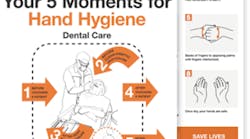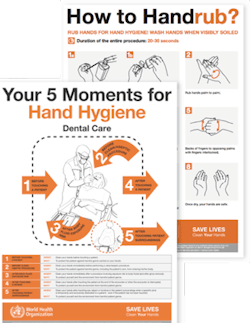The saying goes that "a picture is worth a thousand words." Looking at the World Health Organization's (WHO) "Five Moments of Hand Hygiene in Dentistry" campaign poster, that is so true. This campaign "advocates the need to improve and sustain hand hygiene practices of health-care workers at the right times and in the right way to help reduce the spread of potentially life-threatening infections in health-care facilities." Currently the rate of compliance for hand hygiene procedures is very poor. Studies indicate the rate of compliance overall in the health-care field is about 40%.1,2
The underlying concept is the need for all dental health-care providers (DHCP) to perform hand hygiene at specific times in patient care. During these times, the three points of contact merge. Points of contact consist of the patient, the dental health-care worker, and treatment involving contact with the patient and his or her surroundings (within what is called the patient zone). There is a real need to improve our response by applying hand hygiene to these points of contact.
-----------------------------------------------------------
Other articles by Noel Kelsch
-----------------------------------------------------------
When we're busy working within the immediate patient-care environment, DHCP tend to focus on hand hygiene before and after patient care. Those two areas are very important, but there are five areas that the DHCW should focus on:
1. Before touching a patient
2. Before clean/aseptic procedures
3. After body-fluid exposure event
4. After touching patient
5. After touching patient surroundings
Being aware of these areas can help us solve the challenges of hand hygiene. For example, the five-point concept incorporates the need to perform hand hygiene as close as possible to where delivery of care takes place. One simple solution is to make sure sinks are placed as close as possible to patient care areas and in an easily accessible area. Soap dispensers should be as close as possible to the sink.
A better view of the column posted at above right can be seen at www.who.int/gpsc/5may/dental-care.pdf.
Another simple solution that can contribute to compliance is to use hand sanitizers when the hands are free from debris. It is very important to remember that hand sanitizers containing 60% to 95% isopropanol or ethanol have been shown to reduce the growth of microorganisms, but they are not good cleaning agents and cannot penetrate debris. They were not developed to take the place of hand washing, and if hands are visibly soiled or debris is present, they may not be effective.3,4 (See hand-rub chart). The CDC states, "When hands are visibly dirty or contaminated with proteinaceous material or are visibly soiled with blood or other body fluids, wash hands with either a nonantimicrobial soap and water or an antimicrobial soap and water. If hands are not visibly soiled, wash with an antimicrobial soap and water or use an alcohol-based hand rub for routinely decontaminating hands.5
A picture is worth a thousand words. Matching your actions to the picture that WHO developed can change your hand-hygiene practice, statistics on compliance, and help to keep both you and your patients safe. RDH
NOEL BRANDON KELSCH, RDHAP, is a syndicated columnist, writer, speaker, and cartoonist. She serves on the editorial review committee for the Organization for Safety, Asepsis and Prevention newsletter and has received many national awards. Kelsch owns her dental hygiene practice that focuses on access to care for all and helps facilitate the Simi Valley Free Dental Clinic. She has devoted much of her 35 years in dentistry to educating people about the devastating effects of methamphetamines and drug use. She is a past president of the California Dental Hygienists' Association.
REFERENCES
1. Gould D. J Hosp Infect 1994;28:15-30. 106.
2. Pittet D. Lancet 2000:356;1307-1312.
3. who.int/medicinedocs/documents/s16320e/s16320e.pdf Accessed 7.7.2013
4. Centers for Disease Control and Prevention. Guideline for Hand Hygiene in Health-Care Settings: Recommendations of the Healthcare Infection Control Practices Advisory Committee and the HICPAC/ SHEA/APIC/IDSA Hand Hygiene Task Force. MMWR Morb Mortal Wkly Rep. 2002;51(No. RR-16)
5. Guideline for Hand Hygiene in Health-care Settings. MMWR 2002; vol. 51, no. RR-16.
Past RDH Issues







